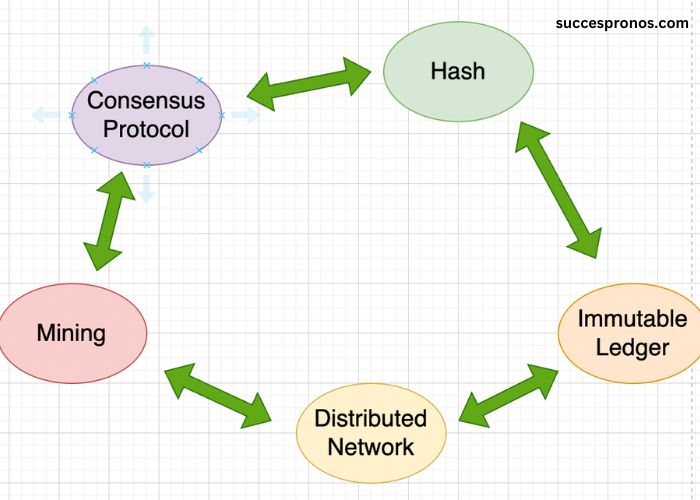
The cryptocurrency Bitcoin has been the focus of general interest for some time now, and with it, often the blockchain technology that makes this concept feasible in the first place. But what exactly is blockchain, and is the hype surrounding the technology justified? One thing right away, this technology you can also find to do your latest sports betting.
Definition: What is a blockchain?
The term blockchain comes from the English language and means blockchain. The “blocks” stand for individual data records stored one after the other, creating a kind of data record chain.
In principle, the blockchain is nothing more than an extensive database that starts with an original block to which new data blocks are added chronologically after they have been checked and confirmed. It, therefore, represents a history of data records (e.g., financial transactions).
The unique feature of the blockchain database is that it is a distributed database. This means that everyone who participates in the blockchain system saves a complete copy of the data history on their computer. This procedure significantly increases the security against manipulation, as even if a copy is manipulated, many correct copies are still available, and the manipulated data record can be “sorted out.” In addition, the sequence of the blocks is additionally secured by a checksum. This prevents the order of the blocks from being subsequently changed.
Even though blockchain is often used for financial transactions, it is essential to understand that it is not limited to one type of information. It can also be used for bookkeeping or backing up music, photos, or texts.
What can blockchain technology be used for?
After the theoretical basics, two practical application scenarios for the technology will now be explained.
Cryptocurrencies
As mentioned in the introduction, the best-known application examples of this technology are cryptocurrencies such as Bitcoin and Ethereum.
Cryptocurrencies are a digital form of currency that is traded and exchanged like regular paper currency. However, unlike paper currencies, financial institutions or the government do not control cryptocurrencies. It should also be noted that not all cryptocurrencies are the same. Each has its unique characteristics and areas of application.
Smart contracts
Smart contracts (“intelligent contracts”) are contracts based on blockchain technology that does not require a third party (e.g., a notary) to ensure legal certainty. Smart contracts can also come into force automatically under certain conditions.
A practical application example of this process is software licensing. Smart contracts make it much easier for users to acquire licenses. However, license sellers also benefit from the use of smart contracts. For example, customers can automatically have their access to the licensed software deactivated if they miss payments.
What are the advantages of blockchain technology?
Now that two possible practical applications have been explained let’s look at the benefits of the technology. So, what added value can it provide?
Security
Once information has been added to the “blockchain” and verified, it can (in principle) no longer be changed:
The complete file is available as a copy on every end device connected to the network.
Manipulation could be detected by comparing the manipulated file with the other files distributed in the network. This would result in the manipulated file being excluded, thereby protecting the original data record. This mechanism represents a safeguard against corruption.
Transparency
It is possible to track and check extensions to the blockchain.
Cost savings
Blockchain data can be relied on without trusting the other party. This eliminates the need for third parties generally involved as supervisory authorities. This reduces the costs incurred.
Time-saving
The technology works like a centralized and digital accounting system, reducing the communication effort between the parties involved. Automation also minimizes the potential for errors. This saves time.
Disadvantages of blockchain – is the hype justified?
A significant disadvantage of this technology is the high storage requirements. The blockchain grows with each additional block, and an increasing amount of data is stored on each network node. As a result, not all transaction scenarios can be mapped this way. Performance is also a disadvantage, as both the verification of transactions and synchronization take time. Furthermore, integrating blockchain into the existing IT architecture is not easy and entails a significant change management effort.
It is also important to note that the blockchain is not entirely tamper-proof. If a participant could control more than half of the nodes, manipulation would be possible. Now that the disadvantages of the technology have been discussed, you may be wondering:
Is the hype justified?
A 2018 Hasso Plattner Institute for Digital Engineering study looked into this issue. The study says that many of the expectations of the technology are too high. Overall, it is still in its infancy. Nevertheless, the researchers see great potential, provided that the weak points are improved in the future. This could ensure that the technology can be used in various areas and industries. The future success of blockchain, therefore, depends on further technology development.
Blockchain as a contrast to the cloud?
As a managed service provider, we aim to relate new technologies to our activities. An interesting perspective in this context is to view blockchain as the antithesis of cloud technology. In contrast to the cloud, the data in the blockchain is not stored centrally; instead, data storage takes place decentrally on all computers in the network.
The areas of application of the two technologies are also different. While blockchain is primarily transaction-based and focuses on security and traceability, cloud technology offers a broader range of applications. It is used, among other things, to partially or eliminate the need for on-premises hardware.